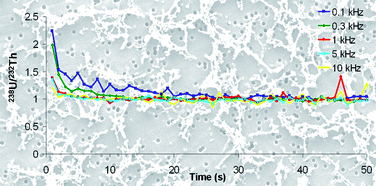An IR-femtosecond laser ablation ICPMS coupling was used to investigate the influence of the high repetition rate on elemental fractionation effects for the analysis of silicate glass SRM NIST 610. First, elemental fractionation inherent to the ICP was minimised by working on wet plasma conditions which had greater tolerance to mass loading and demonstrated a higher robustness compared to dry plasma conditions. Because of the use of a narrow laser beam producing small craters (17 µm in diameter), a special arrangement of pulses was used to perform resulting craters of 100 µm diameter. The ablation strategy developed in this work consisted in a series of concentric circle trajectories ablated at high repetition rates by moving the laser beam rapidly thanks to a scanning beam device. Two scanner speeds (0.25 mm s−1 and 1.5 mm s−1), five laser repetition rates (from 0.1 kHz to 10 kHz) and three fluence values (5 J cm−2, 14 J cm−2, and 25 J cm−2) were investigated in detail. For this purpose, critical elemental ratios (namely 238U/232Th, 208Pb/238U, and 66Zn/65Cu) of aerosols produced by fs-LA of silicate glass were studied to evaluate the impact of the different laser parameters on elemental fractionation. No heating zones or preferential evaporation of elements were found depending on the repetition rate employed. However, particle-size-fractionation was measured during the ablation of the sample surface, and this effect was reduced by using a high repetition rate as well as a high scanner speed which allow the dilution of the large particles coming from the surface layer with finer particles coming to deeper levels. Additionally, the ablation rate induced by the selected ablation strategy had a low influence on fractionation effects due to the high robustness of the ICP plasma and, on the other hand, fractionation indices were not particularly affected by the laser repetition rate although they could be improved by the use of high fluence values. Finally, it could be stressed that no differences on the structure of the aerosol particles collected on membrane filters were found depending on the ablation parameters.

You have access to this article
 Please wait while we load your content...
Something went wrong. Try again?
Please wait while we load your content...
Something went wrong. Try again?


 Please wait while we load your content...
Please wait while we load your content...